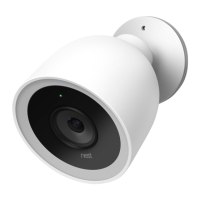2019 | Condential and Proprietary | Do not distribute
Find a good location
Tips for camera placement:
● Nest Cam IQ Outdoor has Supersight close up tracking view, so it can automatically zoom in when it notices a
person. Since it’s more versatile, you should install the camera where it can look over a large area of the
propey like the driveway or yard. They’re not limited to shoer distances, but you can also choose to install
it near the front, back or side door.
● Make sure that there’s nothing too close to where you’ll install the camera. You don’t want anything blocking
the view. For instance, is a post, plant or porch light blocking the view? It might aect the Nest Cam’s
exposure, focus or Night Vision.
● It’s best to angle the camera down so the sun doesn’t shine into the lens. Usually this won’t happen until the
sun is low in the sky early in the morning or at sunset. If you notice glare, adjust the camera so the horizon is
out of the camera’s view.
● Install the camera just about head height in the chosen location. 7 to 10 feet (2 to 3 meters) allows for the
camera to see people’s faces and be close enough to communicate with the speaker and microphone.
● Nest Cam IQ Outdoor is weatherproof, but raindrops or snowakes might stick to the lens. If the home has
eaves or a place that will provide shelter from the weather, see if that will work for the camera location.
Test camera video streaming outside
Thick or insulated walls can greatly reduce Wi-Fi signal strength.
1. Plug in the camera and hold it up to where you’d like to mount it. Check that it can stream video to the Nest app.
2. If you can’t see the camera video, the Wi-Fi connection may not be strong enough there. Try moving your
camera a bit. Sometimes a few inches can make a dierence. You can also try moving the Wi-Fi router.
3. Visit nest.com/wihelp for more information if experiencing issues.
Other items you may need
● A phillips head screwdriver or drill with phillips bit
● Caulk to seal the wall plate and cable hole
● Drill bits
● 3/32" or 2 mm for pilot holes
● 7/32" or 6 mm for wall anchors
● 1/2" or 13 mm for the cable hole
● If you’re drilling into brick or stone, you'll need masonry bits.

